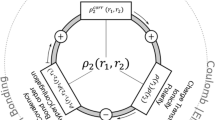Abstract.
In this report, we have derived a formula for evaluating the equilibrium inter nuclear bond distances of heteronuclear diatomics relying upon the concept of hardness equalization principle. We have relied upon the fact that the hardness, like the electronegativity, is a qualitative property and since there is much commonality in the basic philosophy of the origin and the operational significance of these two fundamental descriptors – the electronegativity and the hardness, there should be a physical process of hardness equalization similar to the electronegativity equalization. Starting from the radial dependent formula of computing hardness of atoms suggested by us and relying upon the hypothesis of hardness equalization principle, we have derived an algorithm for computing the equilibrium inter nuclear bond distance of hetero nuclear diatomics as R AB(Å) ≈ C(14.4/\(\eta_{\rm AB}\)), where \(\eta_{\rm AB}\)(eV) is the molecular hardness, C is the constant depends on the fundamental nature of hardness e.g. the bond type, steric factor etc. The optimized value of C is 0.95. We have invoked the algorithm stated above to compute the equilibrium inter nuclear bond lengths of as many as four different sets of compounds with widely divergent chemico-physical properties. In order to explore the efficaciousness of the formula derived in the present work, we have performed a validity test by comparing the theoretically evaluated bond distances vis-à-vis their corresponding spectroscopic counterparts. The comparative study reveals the surprising results that in majority of cases, the theoretical bond distances just superimpose upon the experimental bond distances. Thus, it is transparent that the hardness equalization principle is justifiably a physical process during the formation of molecule.
Similar content being viewed by others
References
R.S. Mulliken, J. Am. Chem. Soc. 74, 811 (1952)
R.G. Pearson, J. Am. Chem. Soc. 85, 3533 (1963)
R.G. Pearson, Science 151, 172 (1966)
G. Klopman, J. Am. Chem. Soc. 86, 1463 (1964)
G. Klopman, J. Am. Chem. Soc. 90, 223 (1968)
P. Hohenberg, H. Kohn, Phys. Rev. 136, 864 (1964)
R.G. Parr, W. Yang, Density Functional Theory of Atoms and Molecules (Oxford University Press, 1989)
E.P. Gyftpoulous, G.N. Hatsopoulos, Proc. Natl. Acad. Sci. 60, 786 (1968)
R.P. Iczkowski, J.L. Margrave, J. Am. Chem. Soc. 83, 3547 (1961)
R.G. Parr, R.A. Donnelly, M. Levy, W.E. Palke, J. Chem. Phys. 68, 3801 (1978)
R.G. Parr, R.G. Pearson, J. Am. Chem. Soc. 105, 7512 (1983)
K.D. Sen, S.C. Vinayagam, Chem. Phys. Lett. 144, 178 (1988)
R.G. Pearson, Proc. Natl. Acad. Sci. 83, 8440 (1986)
J.L. Reed, J. Phys. Chem. A 101, 7396 (1997)
J.P. Perdew, R.G. Parr, M. Levy, J.L. Balduz Jr., Phys. Rev. Lett. 49, 1691 (1982)
W.T. Yang, Y.K. Zhang, P.W. Ayers, Phys. Rev. Lett. 84, 5172 (2000)
P. Geerlings, F.D. Proft, W. Langenaeker, Chem. Rev. 103, 1793 (2003)
R.G. Pearson, J. Chem. Educ. 64, 561 (1987)
R.G. Pearson, Acc. Chem. Res. 26, 250 (1993)
M. Torrent-Sucarrat, J.M. Luis, M. Duran, M. Sola, J. Chem. Phys. 117, 10561 (2002)
M. Torrent-Sucarrat, J.M. Luis, M. Duran, M. Sola, J. Am. Chem. Soc. 123, 7951 (2001)
P.K. Chattaraj, S. Sengupta, J. Phys. Chem. 100, 16126 (1996)
Z. Zhou, R.G. Parr, J. Am. Chem. Soc. 113, 5720 (1991)
R.G. Parr, P.K. Chattaraj, J. Am. Chem. Soc. 113, 1854 (1991)
P.K. Chattaraj, S. Nath, A.B. Sannigrahi, J. Phys. Chem. 98, 9143 (1991)
R.G. Pearson, W.E. Palke, J. Phys. Chem. 96, 3283 (1992)
S. Pal, N. Vaval, R. Roy, J. Phys. Chem. 97, 4404 (1993)
P.K. Chattaraj, G.H. Liu, R.G. Parr, Chem. Phys. Lett. 237, 171 (1995)
P.W. Ayers, R.G. Parr, J. Am. Chem. Soc. 122, 2010 (2000)
D.C. Ghosh, J. Jana, R. Biswas, Int. J. Quantum Chem. 80, 1 (2000)
D.C. Ghosh, J. Jana, S. Bhattacharyya, Int. J. Quantum Chem. 87, 111 (2002)
P.K. Chattaraj, H. Lee, R.G. Parr, J. Am. Chem. Soc. 113, 1855 (1991)
P.K. Chattaraj, P.W. Ayers, J. Melin, Phys. Chem. Chem. Phys. 9, 3853 (2007)
P.K. Chattaraj, P.W. Ayers, J. Chem. Phys. 123, 086101 (2005)
P.W. Ayers, J. Chem. Phys. 122, 141102 (2005)
P.W. Ayers, R.G. Parr, R.G. Pearson, J. Chem. Phys. 124, 194107 (2006)
D.C. Ghosh, N. Islam, Int. J. Quantum Chem. DOI 10.1002/qua.22415 (2010)
W. Yang, C. Lee, S.K. Ghosh, J. Phys. Chem. 85, 5412 (1985)
R.F. Nalewajski, J. Phys. Chem. 89, 2831 (1985)
D. Dutta, J. Phys. Chem. 90, 4211 (1986)
P.W. Ayers, Faraday Discuss. 135, 161 (2007)
M.V. Putz, Absolute and Chemical Electronegativity and Hardness (Nova Science Publishers, Inc., New York, 2008)
R.T. Sanderson, Science 114, 670 (1951)
M. Berkowitz, S.K. Ghosh, R.G. Parr, J. Am. Chem. Soc. 107, 6811 (1985)
S.K. Ghosh, M. Berkowitz, R.G. Parr, Proc. Natl. Acad. Sci. 81, 8028 (1984)
S. Hati, D. Datta, J. Comput. Chem. 13, 912 (1992)
D.C. Ghosh, N. Islam, Int. J. Quantum Chem. (2010), DOI 10.1002/qua.22508
D.C. Ghosh, N. Islam, Int. J. Quantum Chem. (2010), DOI 10.1002/qua.22499
P.W. Ayers, R.G. Parr, J. Chem. Phys. 128, 184108 (2008)
P.W. Ayers, R.G. Parr, J. Chem. Phys. 129, 054111 (2008)
R.P. Feynman, R.B. Leighton, M. Sands, The Feynman Lecture on Physics (Addison-Wesley: Mass., 1964), Vol. II
D.C. Ghosh, R. Biswas, Int. J. Mol. Sci. 3, 87 (2002)
D.C. Ghosh, N. Islam, Int. J. Quantum Chem. 110, 1206 (2009)
T.K. Ghanty, S.K. Ghosh, J. Phys. Chem. 100, 12295 (1996)
T.K. Ghanty, S.K. Ghosh, J. Phys. Chem. 97, 4951 (1993)
F.J. Lovas, E. Tiemann, J. Phys. Chem. Ref. Data 3, 609 (1974)
P. Pyykkö, M. Atsumi, Chem. Eur. J. 15, 186 (2009)
Hyperchem, 8.0.6 (Hypercube Inc, 2008)
Author information
Authors and Affiliations
Corresponding author
Rights and permissions
About this article
Cite this article
Islam, N., Ghosh, D. A new algorithm for the evaluation of equilibrium inter nuclear bond distance of heteronuclear diatomic molecules based on the hardness equalization principle. Eur. Phys. J. D 61, 341–348 (2011). https://doi.org/10.1140/epjd/e2010-10058-6
Received:
Revised:
Published:
Issue Date:
DOI: https://doi.org/10.1140/epjd/e2010-10058-6




